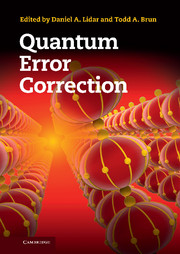Book contents
- Frontmatter
- Contents
- List of contributors
- Prologue
- Preface and guide to the reader
- Acknowledgements
- Part I Background
- Part II Generalized approaches to quantum error correction
- Part III Advanced quantum codes
- Part IV Advanced dynamical decoupling
- Part V Alternative quantum computation approaches
- 16 Holonomic quantum computation
- 17 Fault tolerance for holonomic quantum computation
- 18 Fault-tolerant measurement-based quantum computing
- Part VI Topological methods
- Part VII Applications and implementations
- Part VIII Critical evaluation of fault tolerance
- References
- Index
18 - Fault-tolerant measurement-based quantum computing
from Part V - Alternative quantum computation approaches
Published online by Cambridge University Press: 05 September 2013
- Frontmatter
- Contents
- List of contributors
- Prologue
- Preface and guide to the reader
- Acknowledgements
- Part I Background
- Part II Generalized approaches to quantum error correction
- Part III Advanced quantum codes
- Part IV Advanced dynamical decoupling
- Part V Alternative quantum computation approaches
- 16 Holonomic quantum computation
- 17 Fault tolerance for holonomic quantum computation
- 18 Fault-tolerant measurement-based quantum computing
- Part VI Topological methods
- Part VII Applications and implementations
- Part VIII Critical evaluation of fault tolerance
- References
- Index
Summary
Introduction
In the standard model of quantum computation [D95], some simple quantum state is prepared and evolved by a partially ordered set of unitary gates, and finally is measured in the computation basis. Up until the late 1990s, transformations that deviate from unitarity were commonly associated with irreversibility, and thus incoherence and harm induced in the quantum data of interest. However, this viewpoint was challenged by three notable results: (1) teleportation [BBC+93], (2) syndrome measurements [S95, S96e], and (3) the fault-tolerant Toffoli and π/8-gate constructions [S96b, BMP+99]. In these schemes, well-designed measurements project the quantum data of interest onto a subspace of the original ambient space for each outcome, up to some known unitary transformation that is either reversible (and harmless) or intended. Subsequently, researchers found many useful error-correction procedures and unitary gates that rely heavily on measurements.
Two “measurement models” of quantum computation were proposed in the early 2000s that make extreme use of measurements. In the cluster model [RB01], any quantum computation can be performed by applying a partially time-ordered set of single-qubit measurements on a certain entangled state. The state must be of appropriate size, but is otherwise independent of the computation. The related graph state model [RBB03] uses an initial state that depends on the computation itself. In the seemingly different teleportation-based model [N03, L01a, L04], any quantum computation can be implemented by applying one- or two-qubit nondemolition measurements on an arbitrary initial state, so as to “teleport” each gate in the simulated circuit.
- Type
- Chapter
- Information
- Quantum Error Correction , pp. 432 - 452Publisher: Cambridge University PressPrint publication year: 2013



